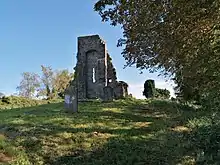St Finian's Esker church and graveyard
St Finian's Esker church and graveyard is an historical site in Esker, Lucan, Dublin. It contains a medieval church in ruins and an enclosed graveyard. The graveyard has over 50 extant memorials from the early 18th century to the early 20th century. Both the church and graveyard are protected structures in the ownership of South Dublin County Council.[1]
| St Finian's Esker church and graveyard | |
|---|---|
 West gable end of St. Finian's church ruin, Esker, Co. Dublin | |
 St Finian's Esker church and graveyard | |
| 53.3498953°N 6.4378233°W | |
| Location | Esker, Lucan, Dublin |
| Country | Ireland |
| Denomination | Pre-Reformation Catholic |
| History | |
| Founded | 13th century |
| Architecture | |
| Years built | 17th century |
| Specifications | |
| Materials | stone |
| Administration | |
| Diocese | Dublin |
Location and history
Situated in the suburban area of Esker, County Dublin near Lucan village. The church and graveyard are sited on a hill with views of the surrounding area. The location is significant as it on the Esker Riada along the Slighe Mhór, one of the five main ancient routes through the country.
Esker was one of four Medieval Royal Manors of Dublin.[2] The church is near the site of the original Manor House of Esker and an ancient stone bridge constructed in the reign of King John of England, locally referred to as King John’s Bridge. The church and graveyard are recorded in the National Inventory of Architectural Heritage[3] and by the National Monument Service of Ireland.[4] It is a nave and chancel style parish church and has been reconstructed over many periods of use.
Features
The church is long and narrow. Records show it was re-roofed in the 16th century but was in ruin by the early 17th century.[5] The west gable wall is buttressed and likely supported a double bellcote, it has a long and narrow embrasure. There is a double ogee arch window in the South wall. Only the foundations of the East wall remains.[4] There is a short horizontal length of herringbone masonry in the North wall which is uncommon in Irish churches.
Notable Memorials
There are several notable memorials including one for a priest, Father James McCartan who was interred here following his murder in nearby Lucan in 1807.[6] Another distinctive memorial depicts a carved skull and crossbones in a memento mori motif. A transcription of the gravestones was published in 1989 and contains records of approximately 60 memorials.[7]
Conservation
In 2019 the site was selected as the first Dublin monument in the Heritage Council "Adopt a Monument" scheme.[8] In October 2020 conservation work commenced to stabilise the structure. Funding was provided by the National Monuments Service Community Monuments Fund through the Department of Housing, Local Government and Heritage and also supported by South Dublin County Council.[9]
References
- "Protected Structures". SDCC. Retrieved 2020-11-12.
- Foley, Áine. The royal manors of medieval Co. Dublin : crown and community. Dublin, Ireland. ISBN 978-1-84682-388-6. OCLC 856578826.
- National Inventory of Architectural Heritage Ireland (21 May 2002). "Esker Church Graveyard, Esker, South Dublin County". Buildings of Ireland. Retrieved 12 November 2020.
- "ArcGIS Web Application". maps.archaeology.ie. Retrieved 2020-11-12.
- Francis Elrington Ball (1906). A History of the County Dublin:: The People, Parishes and Antiquities from the Earliest Times to ... New York Public Library. Printed and published by Alex. Thom & Co . (Limited), Abbey-St.
- William S. Donegan (1902). Lucania, Topographical, Biographical, Historical: Murders of Father McCarthy, Curate of Lucan ... New York Public Library. Browne & Nolan, limited.
- Egan, Dr Michael JS; Power, David (1989-12-26). "Transcription of the burials in St. Finian's Churchyard, Esker, Lucan". source.southdublinlibraries.ie. Retrieved 2020-11-12.
- "St. Finian's Church & Graveyard, Lucan, County Dublin - Heritage Council". www.heritagecouncil.ie. Retrieved 2020-11-12.
- "Detail of Community Monuments Fund 2020 Awards | National Monuments Service". www.archaeology.ie. Retrieved 2020-11-12.